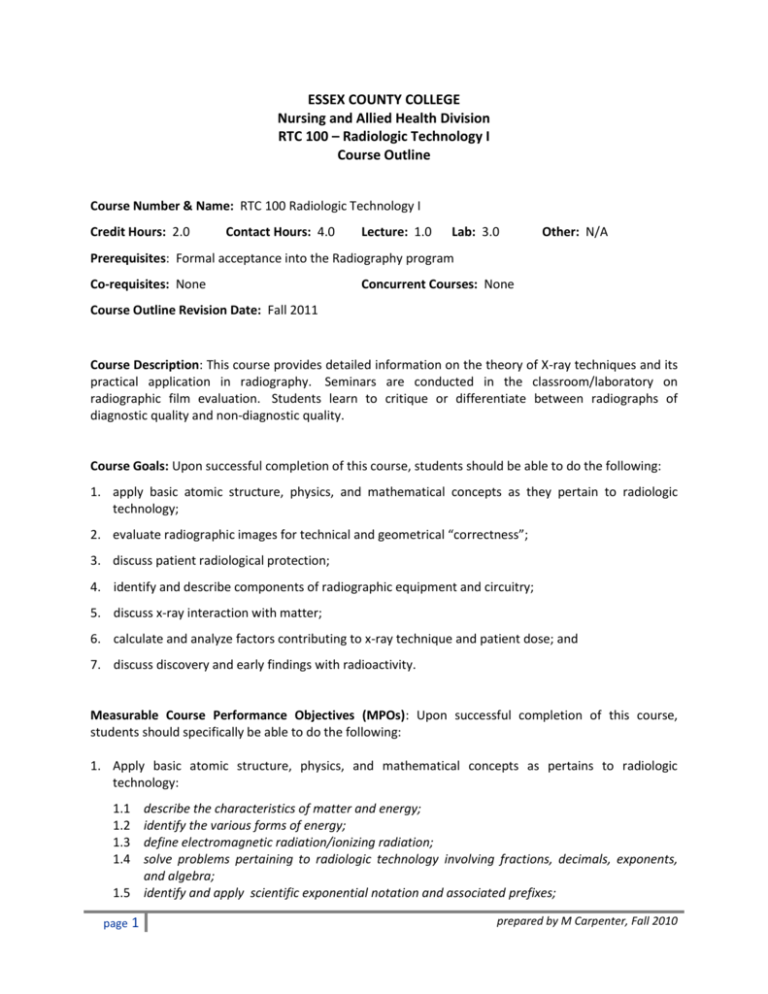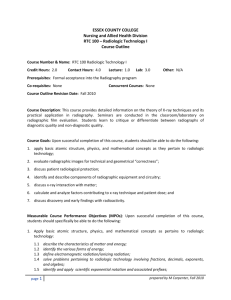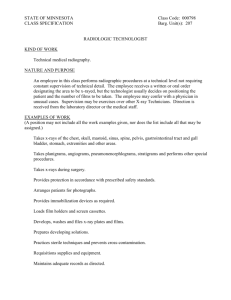rtc.100.outline.f2011 - Student Learning Outcomes (SLO)
advertisement

ESSEX COUNTY COLLEGE Nursing and Allied Health Division RTC 100 – Radiologic Technology I Course Outline Course Number & Name: RTC 100 Radiologic Technology I Credit Hours: 2.0 Contact Hours: 4.0 Lecture: 1.0 Lab: 3.0 Other: N/A Prerequisites: Formal acceptance into the Radiography program Co-requisites: None Concurrent Courses: None Course Outline Revision Date: Fall 2011 Course Description: This course provides detailed information on the theory of X-ray techniques and its practical application in radiography. Seminars are conducted in the classroom/laboratory on radiographic film evaluation. Students learn to critique or differentiate between radiographs of diagnostic quality and non-diagnostic quality. Course Goals: Upon successful completion of this course, students should be able to do the following: 1. apply basic atomic structure, physics, and mathematical concepts as they pertain to radiologic technology; 2. evaluate radiographic images for technical and geometrical “correctness”; 3. discuss patient radiological protection; 4. identify and describe components of radiographic equipment and circuitry; 5. discuss x-ray interaction with matter; 6. calculate and analyze factors contributing to x-ray technique and patient dose; and 7. discuss discovery and early findings with radioactivity. Measurable Course Performance Objectives (MPOs): Upon successful completion of this course, students should specifically be able to do the following: 1. Apply basic atomic structure, physics, and mathematical concepts as pertains to radiologic technology: 1.1 1.2 1.3 1.4 describe the characteristics of matter and energy; identify the various forms of energy; define electromagnetic radiation/ionizing radiation; solve problems pertaining to radiologic technology involving fractions, decimals, exponents, and algebra; 1.5 identify and apply scientific exponential notation and associated prefixes; page 1 prepared by M Carpenter, Fall 2010 Measurable Course Performance Objectives (MPOs) (continued): 1.6 1.7 1.8 1.9 1.10 1.11 1.12 1.13 1.14 1.15 1.16 1.17 1.18 1.19 1.20 discuss the history of the atom; identify the structure of the atom; describe electron shells and instability within atomic structure; discuss radioactivity and the characteristics of alpha and beta particles; explain the difference between two forms of ionizing radiation: particulate and electromagnetic; state the properties of photons; demonstrate proper use of the inverse square law; identify the electromagnetic spectrum; define electrification and provide examples; list the laws of electrostatics and electromagnetic induction; identify units of electric current, electric potential, and electric power; describe the interactions between matter and magnetic fields; explain the four laws of magnetism; reference the experiments of Oersted, Lenz, and Faraday in defining the relationships between electricity and magnetism; and identify the laws of electromagnetic induction 2. Evaluate radiographic images for technical and geometrical “correctness”: 2.1 identify on a radiograph high contrast versus low contrast and long scale versus short scale; 2.2 identify on a radiograph over- and underexposure as related to density, brightness, exposure index, and sensitivity number; and 2.3 identity on a radiograph factors contributing to resolution and detail (magnification/motion), effects of pixel and matrix size 3. Discuss patient radiological protection: 3.1 3.2 3.3 3.4 list and define units of radiation and radioactivity; discuss patient protection in terms of shielding; evaluate patient radiological protection; and list the concepts of basic radiation protection 4. Identify and describe components of radiographic equipment and circuitry: 4.1 identify the components of the operating console positioned outside the x-ray examination room; 4.2 explain the operation of the high-voltage generator, including the filament transformer and the rectifiers; 4.3 relate the important differences among single-phase, three-phase, and high-frequency power; 4.4 identify the voltage ripple associated with various high-voltage generators; 4.5 discuss the importance of voltage ripple to x-ray quantity and quality; and 4.6 define the power rating of an x-ray imaging system page 2 prepared by M Carpenter, Fall 2010 Measurable Course Performance Objectives (MPOs) (continued): 5. Discuss x-ray interaction with matter: 5.1 5.2 5.3 5.4 5.5 5.6 5.7 5.8 5.9 5.10 discuss the interactions between projectile electrons and the x-ray tube target; identify characteristic and bremsstrahlung x-rays; describe the x-ray emission spectrum; explain how mAs, kVp, added filtration, target material, and voltage ripple affect the x-ray emission spectrum; describe each of the five x-ray interactions with matter; define differential absorption and describe its effect on image contrast; explain the effect of atomic number and mass density of tissue on differential absorption; discuss why radiologic contrast agents are used to image some tissues and organs; explain the difference between absorption and attenuation; and state the relative intensity of ionizing radiation from various sources 6. Calculate and analyze factors contributing to x-ray technique and patient dose: 6.1 6.2 6.3 6.4 define radiation quantity and its relation to x-ray intensity; list and discuss the factors that affect the intensity of the x-ray beam; explain x-ray quality and penetrability; and list and discuss the factors that affect the quality of the x-ray beam 7. Discuss discovery and early findings with radioactivity: 7.1 discuss the accidental discovery of x-rays by Roentgen; and 7.2 give examples of human injury caused by radiation Methods of Instruction: Instruction will consist of lectures, class discussions/participation, PowerPoint slide shows, class activities, radiograph review, and laboratory activities. Outcomes Assessment: Test and exam questions are blueprinted to the course objectives which are based on the minimum standards required by the American Radiology of Radiologic Technologists (ARRT) and the American Society of Radiologic Technologists (ASRT) suggested course curriculum. NOTE: Tests and exams are primarily structured in multiple-choice formats in conjunction with the ARRT exam. Also, checklist rubrics may be used to evaluate students for the level of mastery of course objectives. page 3 prepared by M Carpenter, Fall 2010 Course Requirements: All students are required to: 1. Read the textbook and do the suggested homework problems in a timely manner. 2. Attend and be an active participant in all classes. 3. Take tests/exams in class and adhere to the test/exam schedule. 4. Turn off cell phones while in class. 5. Remain in the classroom during the entire class period. 6. Earn a “C” or better to pass this class. Students who do not earn a “C” or better will be required to withdraw from the Radiography Program as per program policy. Methods of Evaluation: Final course grades will be computed as follows: Grading Components % of final course grade 12 or more Tests (dates specified by the instructor) Tests will be administered weekly throughout the semester to test student mastery of course objectives. 75% Midterm Exam The midterm exam format may consist of multiple choice, short answer, and true/false questions and will include material from the readings, homework, lectures, and labs covered throughout the semester. The midterm exam will test the students’ mastery of course objectives and synthesis of course material covered from the beginning through the first half of the semester. 12.5% Final Exam The final exam format may consist of multiple choice, short answer, and true/false questions and will include material from the readings, homework, lectures, and labs covered throughout the semester. The final exam will test the students’ mastery of course objectives and synthesis of course material covered throughout the entire semester. 12.5% page 4 prepared by M Carpenter, Fall 2010 Academic Integrity: Dishonesty disrupts the search for truth that is inherent in the learning process and so devalues the purpose and the mission of the College. Academic dishonesty includes, but is not limited to, the following: plagiarism – the failure to acknowledge another writer’s words or ideas or to give proper credit to sources of information; cheating – knowingly obtaining or giving unauthorized information on any test/exam or any other academic assignment; interference – any interruption of the academic process that prevents others from the proper engagement in learning or teaching; and fraud – any act or instance of willful deceit or trickery. Violations of academic integrity will be dealt with by imposing appropriate sanctions. Sanctions for acts of academic dishonesty could include the resubmission of an assignment, failure of the test/exam, failure in the course, probation, suspension from the College, and even expulsion from the College. Student Code of Conduct: All students are expected to conduct themselves as responsible and considerate adults who respect the rights of others. Disruptive behavior will not be tolerated. All students are also expected to attend and be on time for all class meetings. No cell phones or similar electronic devices are permitted in class. Please refer to the Essex County College student handbook, Lifeline, for more specific information about the College’s Code of Conduct and attendance requirements. page 5 prepared by M Carpenter, Fall 2010 Course Content Outline: based on the texts Radiologic Science for Technologists Physics, Biology, and Protection, 9th edition, by Stewart Carlyle Bushong; ISBN #: 978-0-323-04837-8; and Radiologic Science for Technologists Physics, Biology, and Protection Workbook and Laboratory Manual, 9th edition, by Stewart Carlyle Bushong; ISBN #: 978-0-323-04838-5 In addition, the following YouTube videos are required viewing: http://www.youtube.com/watch?v=JW3tT0L2gpc – Inverse Square Law http://www.youtube.com/watch?v=RIGp1k0Nt2I – Induction Motor http://www.youtube.com/watch?v=stUDqGzpev8 – Faraday’s Law of Induction http://www.youtube.com/watch?v=hQtgQLshrus&feature=related – Homemade Motor http://www.youtube.com/watch?v=fKt3_Vy12m8&NR=1 – Homemade Motor Details http://www.youtube.com/watch?v=RueXmL-Dz3w&NR=1 – History of Radiography (for use with x-ray tube lecture) Week Topics covered 1 Review class syllabus, Review Bushong Chapters 1 & 2 – Density, Contrast, Resolution, Detail, Distortion, Review Radiographs Complete Bushong Review 2 Test 1 Bushong Chapter 3 – The Atom, Radioactivity, and Radiation The x-ray beam, central ray Film versus Digital imaging pixel versus matrix Exposure Index 3 Test 2 Bushong Chapter 4 – Electromagnetic Energy Radiation Protection, Patient Preparation 4 Test 3 Bushong Chapter 5 – Electricity, Magnetism, and Electromagnetism Proper radiograph identification and method of review 5 Test 4 Complete Bushong Chapter 5 Chapter 5 Workbook activities 6 Test 5 Review Chapter 5 Perform energized lab experiments SID/SOD/image production page 6 prepared by M Carpenter, Fall 2010 Week Topics covered 7 Test 6 Bushong Chapter 6 – Imaging System Console and Generator 8 Midterm Exam Bushong Chapter 6 – Imaging System Circuit 9 Test 7 Bushong Chapter 6 – Imaging System Single Phases, Three Phase, and High Frequency Waveforms 10 Test 8 Bushong Chapter 7 – The X-ray Tube The x-ray tube/focal spot size/tube cooling charts/lab experiment anode Heel effect 11 Test 9 Begin Bushong Chapter 8 – X-ray Production 12 Test 10 Complete x-ray production Begin Bushong Chapter 9 – X-ray Emission Lab experiments involving x-ray intensity/penetration/half value layer/ filtration 13 Test 11 Bushong Chapter 10 – Interaction with Matter 14 Test 12 Bushong Chapter 11 – Review Radiographic Film/Digital IR’s 15 Final Exam page 7 prepared by M Carpenter, Fall 2010
![Physics of Radiologic Imaging [Opens in New Window]](http://s3.studylib.net/store/data/008568907_1-1e7d7b82bfd2882a3a695d3f7c130835-300x300.png)





